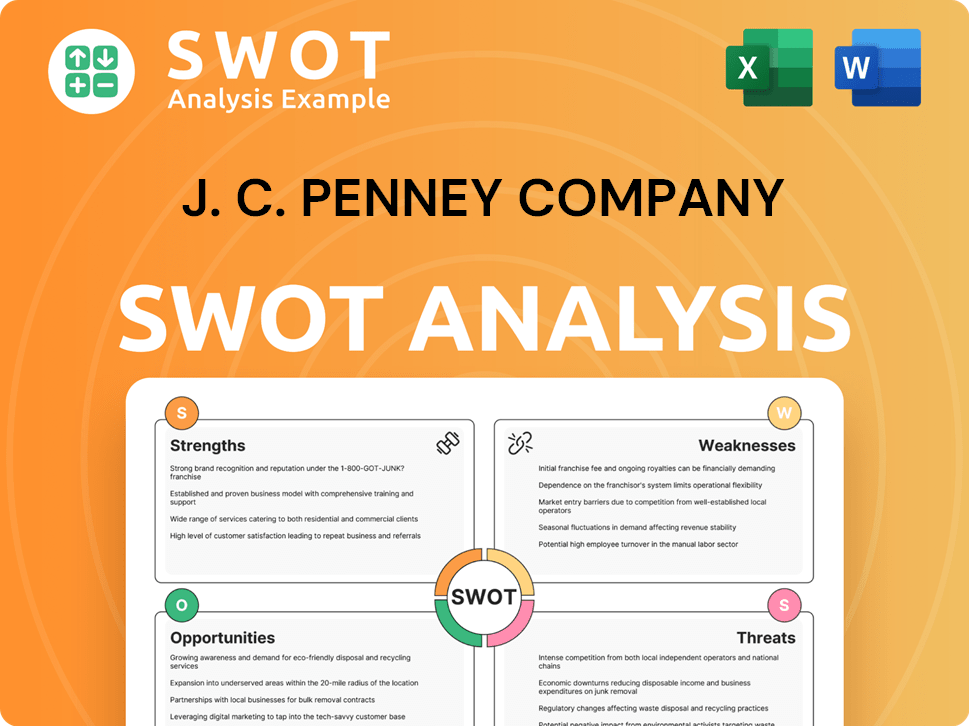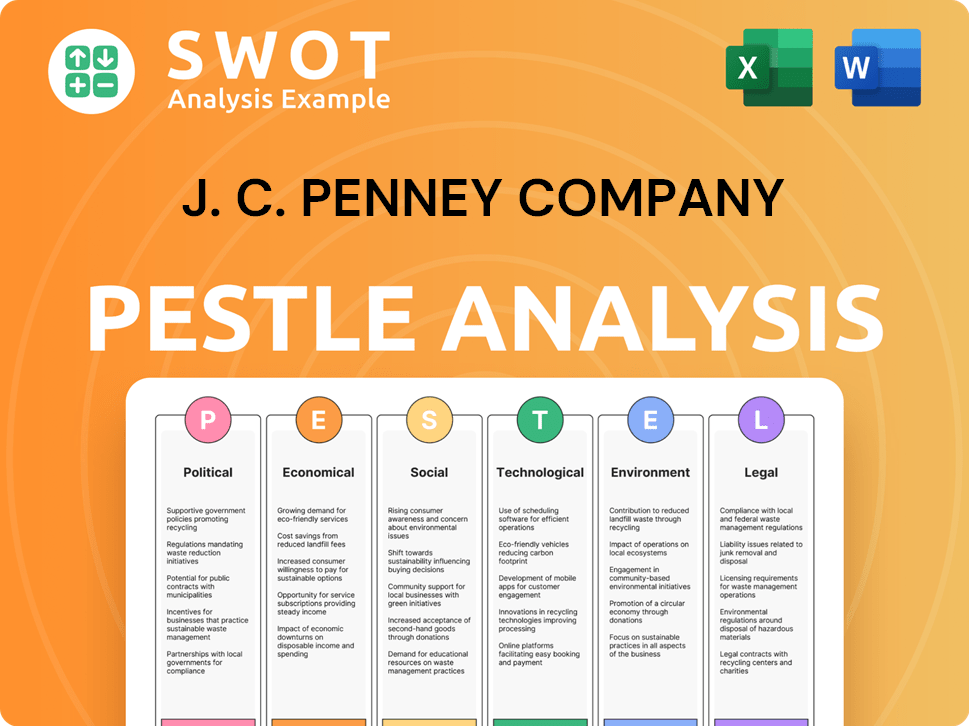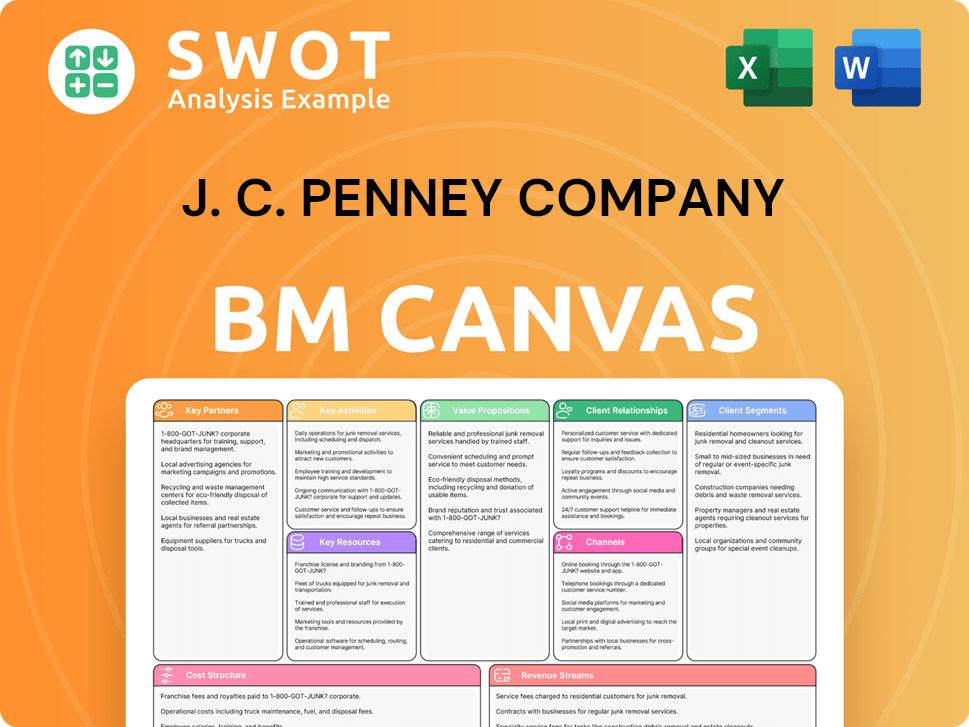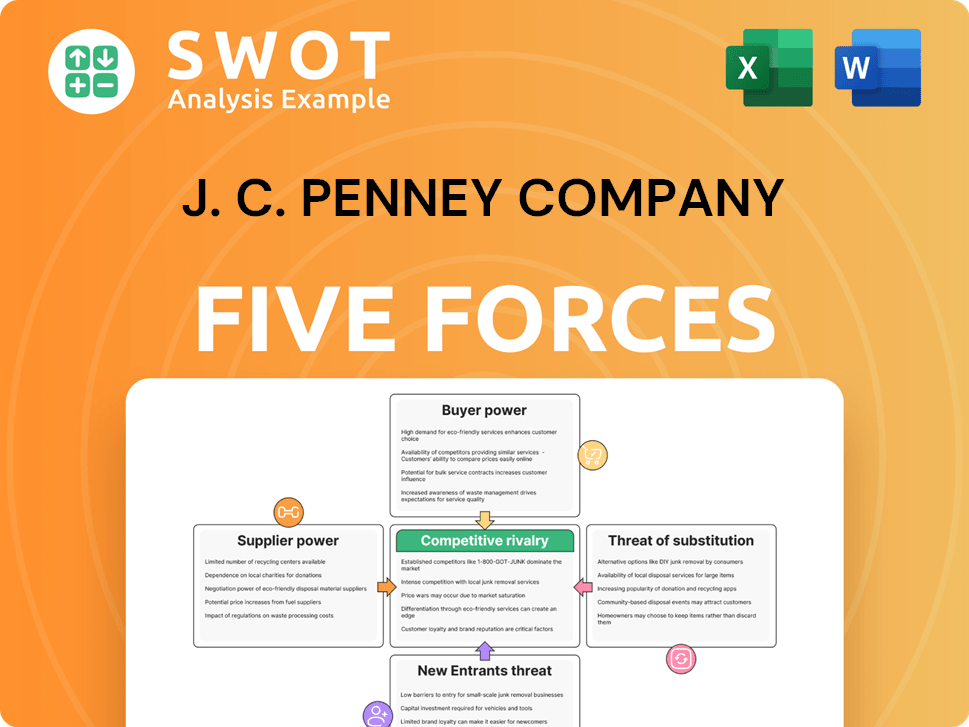J. C. Penney Company Bundle
How well do you know the JCPenney story?
Journey back in time to explore the remarkable J. C. Penney Company SWOT Analysis, a retail giant with a legacy spanning over a century. From its humble beginnings in 1902, JCPenney has shaped the American retail landscape, leaving an indelible mark on how we shop and what we expect from businesses. Discover how this iconic department store chain rose to prominence, driven by a simple yet powerful philosophy.

The story of JCPenney, from Penney's origins, is a testament to the power of vision and adaptability within the retail industry timeline. James Cash Penney's 'Golden Rule' store concept revolutionized customer relations, fostering trust and loyalty that propelled the company's early growth. Through understanding key events in J. C. Penney's history, we can appreciate its enduring influence on the American economy and its ongoing efforts to navigate the complexities of modern retail.
What is the J. C. Penney Company Founding Story?
The story of the J. C. Penney Company, a significant part of department store history, began on April 14, 1902. James Cash Penney, along with partners Thomas Callahan and Guy Johnson, launched the first store. This marked the start of a retail empire that would reshape the industry.
The initial store, known as 'The Golden Rule Store,' was established in Kemmerer, Wyoming. This small mining town of about 1,000 residents was the perfect location to test Penney's vision. Penney's commitment to offering 'Honest Value for Your Money' set the foundation for the company's future success.
Penney invested his life savings of $2,000 and borrowed additional capital to become a one-third partner. His early business model, which focused on cash-only transactions, helped establish trust and competitive pricing. By 1907, Penney had bought out his partners, gaining full control of the stores. The company's headquarters moved to Salt Lake City, Utah, in 1909, to be closer to banking and railroad facilities. The J. C. Penney Company, Inc., was officially incorporated on January 17, 1913, with William Henry McManus as a co-founder.
The early days of J. C. Penney highlight the company's humble beginnings and commitment to customer value.
- The first store, 'The Golden Rule Store,' opened in Kemmerer, Wyoming, in 1902.
- James Cash Penney invested his savings and borrowed to start the business.
- The company's initial focus was on providing quality goods at fair prices.
- The cash-only business model helped build trust and competitive pricing.
The company's early years were marked by resourcefulness. James Cash Penney and his family lived in the unfinished attic of the first store for over a year, using shipping crates as furniture. This period highlights the dedication and determination that drove the company's early expansion. For further insights into the company's strategic approach, you can explore the Marketing Strategy of J. C. Penney Company.
J. C. Penney Company SWOT Analysis
- Complete SWOT Breakdown
- Fully Customizable
- Editable in Excel & Word
- Professional Formatting
- Investor-Ready Format

What Drove the Early Growth of J. C. Penney Company?
The early growth of the J. C. Penney Company, a pivotal moment in Department store history, was marked by rapid expansion and a commitment to its founding principles. This period saw the company evolve from a small chain to a significant player in the retail industry. The expansion strategy and business model changes were key to its early success.
By 1912, the company, then operating as "The Golden Rule," had expanded to 34 stores, with annual sales reaching $2 million. Following its incorporation in 1913, the company continued to grow, operating 175 stores across 22 states by 1917. The headquarters relocated to New York City in 1914 to streamline operations.
A significant milestone was the opening of the 500th store in Hamilton, Missouri, James Cash Penney's hometown, in 1924. By 1928, when the 1,000th store opened, gross business had reached $190 million, equivalent to $3.48 billion in 2025. By 1941, JCPenney operated 1,600 stores across all 48 states.
The company diversified its offerings, acquiring The Crescent Corset Company in 1920, its first wholly owned subsidiary. In 1956, JCPenney began national advertising through a series of advertisements in Life magazine. In 1959, it issued its first credit cards, marking a shift from its traditional cash-and-carry approach.
The company entered the mail-order business in 1962 by acquiring the General Merchandise Co., launching its first catalog the following year. By 1959, the company had over 1,700 stores. The late 1960s saw international expansion with the acquisition of Sarma, SA, a Belgian retail chain, and entry into the Italian retail market in 1971. JCPenney also ventured into the retail pharmacy business with the purchase of Thrift Drug Company in 1969.
J. C. Penney Company PESTLE Analysis
- Covers All 6 PESTLE Categories
- No Research Needed – Save Hours of Work
- Built by Experts, Trusted by Consultants
- Instant Download, Ready to Use
- 100% Editable, Fully Customizable

What are the key Milestones in J. C. Penney Company history?
The J. C. Penney history is marked by significant achievements and changes. From its humble beginnings to its evolution into a major department store, the company has seen numerous shifts in the retail industry timeline.
| Year | Milestone |
|---|---|
| 1902 | James Cash Penney opened his first store, the Golden Rule store, in Kemmerer, Wyoming. |
| 1959 | Introduced its own credit cards, moving away from a cash-only model. |
| 1963 | Launched its first catalog, broadening its customer base. |
| 1971 | Became one of the first major retailers to offer online shopping. |
| 1983 | Introduced the Arizona Jean Company, an exclusive brand. |
| 2006 | Launched the 'Sephora inside' concept, integrating a popular beauty retailer into its stores. |
Penney's origins include several innovations. The company was an early adopter of the chain store concept, which helped to improve operational efficiency. Additionally, it embraced digital commerce early on, demonstrating a commitment to adapting to changing consumer behaviors.
JCPenney company was a pioneer in online retail, launching its website in 1971. This early move allowed the company to reach a broader audience and adapt to the evolving retail landscape.
The introduction of exclusive brands, like Arizona Jean Company in 1983, helped J. C. Penney history to differentiate itself. These brands provided unique offerings, attracting customers and building brand loyalty.
The launch of its catalog in 1963 was a significant innovation, expanding its reach. This allowed JCPenney company to serve customers beyond its physical store locations, especially in rural areas.
The introduction of its own credit cards in 1959 was a major shift. This move provided customers with more purchasing options, boosting sales and customer loyalty.
The 'Sephora inside JCPenney' concept, launched in 2006, was a strategic partnership. This brought a popular beauty retailer into its stores, attracting new customers and enhancing the shopping experience.
J. C. Penney's history embraced the chain store concept early on. This allowed for greater operational efficiency, including centralized purchasing and standardized store layouts, contributing to its growth and profitability.
J. C. Penney history has faced significant challenges, particularly in the 21st century. The rise of online retail and changes in shopping habits have impacted the company. The COVID-19 pandemic exacerbated these issues, leading to financial difficulties and strategic restructuring.
JCPenney company experienced financial struggles due to the rise of internet retail and declining mall traffic. This led to a Chapter 11 bankruptcy filing in May 2020, forcing the company to restructure its operations.
As part of its restructuring, J. C. Penney history closed numerous stores. Eight additional locations are scheduled to close by mid-2025, reflecting the ongoing need to adapt to market changes.
The COVID-19 pandemic significantly worsened the challenges faced by JCPenney company. The pandemic led to temporary store closures and reduced consumer spending, accelerating the need for strategic pivots.
The Chapter 11 bankruptcy filing in May 2020 was a critical event in J. C. Penney's history. This led to a comprehensive restructuring plan, including store closures and a focus on digital transformation.
Changes in consumer behavior, such as the shift towards online shopping, have posed significant challenges. J. C. Penney's history has had to adapt to these shifts to remain competitive.
Intense competition from online retailers has put pressure on J. C. Penney's history. This has necessitated investments in e-commerce and efforts to enhance the in-store experience.
For more details on the company's values, you can read about the Mission, Vision & Core Values of J. C. Penney Company.
J. C. Penney Company Business Model Canvas
- Complete 9-Block Business Model Canvas
- Effortlessly Communicate Your Business Strategy
- Investor-Ready BMC Format
- 100% Editable and Customizable
- Clear and Structured Layout

What is the Timeline of Key Events for J. C. Penney Company?
The Owners & Shareholders of J. C. Penney Company, JCPenney, has a rich history, starting with the opening of James Cash Penney's first 'Golden Rule Store' in Kemmerer, Wyoming, on April 14, 1902. The company's journey includes significant milestones such as incorporation in 1913, going public on the New York Stock Exchange, and the launch of its catalog in 1963. The company issued its first credit cards in 1959. The company expanded its reach with the launch of jcpenney.com in 1998. JCPenney's history also includes the Sephora partnership in 2006, bankruptcy in May 2020, and emergence from bankruptcy in December 2020 under new ownership. In recent years, the company has focused on modernization and strategic partnerships, including a $1 billion turnaround plan unveiled in September 2023 and the revamping of its loyalty program in April 2024. The company merged with Sparc Group to form Catalyst Brands in January 2025.
| Year | Key Event |
|---|---|
| 1902 | James Cash Penney opens his first 'Golden Rule Store' in Kemmerer, Wyoming. |
| 1913 | The company is incorporated as J. C. Penney Company, Inc. and goes public on the New York Stock Exchange. |
| 1924 | JCPenney opens its 500th store. |
| 1959 | JCPenney credit cards are first issued. |
| 1963 | The company launches its first catalog. |
| 1971 | James Cash Penney dies; the company adopts the 'JCPenney' moniker in advertising. |
| 1998 | JCPenney launches jcpenney.com for internet shopping. |
| 2006 | The 'Sephora inside JCPenney' concept is launched. |
| 2020 | JCPenney files for Chapter 11 bankruptcy protection in May and emerges from bankruptcy in December. |
| 2023 | JCPenney unveils a $1 billion turnaround plan in September. |
| 2024 | JCPenney revamps its loyalty program in April and extends its financing partnership with Synchrony to include 'Buy Now, Pay Later' in October. |
| 2025 | JCPenney merges with Sparc Group to form Catalyst Brands in January, with eight additional store closures expected mid-year. |
JCPenney plans to upgrade its 650+ store fleet with new point-of-sale systems and enhanced WiFi within the next two years. This initiative is part of the company's broader strategy to modernize its physical retail spaces. The focus is on creating a better shopping experience for customers.
The company is prioritizing the use of AI and machine learning to improve supply chain operations. This includes better inventory management and enhancing the overall customer experience. These technological advancements are crucial for efficiency.
JCPenney is focused on strategic partnerships, such as the 2024 LIFT Beauty Accelerator. This approach aims to support female-identifying beauty brand founders. Collaborations with celebrities, including Gabrielle Union and Ashley Graham, are also part of this strategy.
In Q3 2024, net sales declined by 8.0% to $1.4 billion, but net loss decreased to $17 million. The company maintains significant liquidity of approximately $1.6 billion. Analyst Neil Saunders noted that while 2024 was 'another lost year,' the situation is manageable. Q1 2024 sales fell 8.1% to $1.37 billion, and the company swung to a $63 million net loss.
J. C. Penney Company Porter's Five Forces Analysis
- Covers All 5 Competitive Forces in Detail
- Structured for Consultants, Students, and Founders
- 100% Editable in Microsoft Word & Excel
- Instant Digital Download – Use Immediately
- Compatible with Mac & PC – Fully Unlocked

Related Blogs
- What is Competitive Landscape of J. C. Penney Company Company?
- What is Growth Strategy and Future Prospects of J. C. Penney Company Company?
- How Does J. C. Penney Company Company Work?
- What is Sales and Marketing Strategy of J. C. Penney Company Company?
- What is Brief History of J. C. Penney Company Company?
- Who Owns J. C. Penney Company Company?
- What is Customer Demographics and Target Market of J. C. Penney Company Company?
Disclaimer
All information, articles, and product details provided on this website are for general informational and educational purposes only. We do not claim any ownership over, nor do we intend to infringe upon, any trademarks, copyrights, logos, brand names, or other intellectual property mentioned or depicted on this site. Such intellectual property remains the property of its respective owners, and any references here are made solely for identification or informational purposes, without implying any affiliation, endorsement, or partnership.
We make no representations or warranties, express or implied, regarding the accuracy, completeness, or suitability of any content or products presented. Nothing on this website should be construed as legal, tax, investment, financial, medical, or other professional advice. In addition, no part of this site—including articles or product references—constitutes a solicitation, recommendation, endorsement, advertisement, or offer to buy or sell any securities, franchises, or other financial instruments, particularly in jurisdictions where such activity would be unlawful.
All content is of a general nature and may not address the specific circumstances of any individual or entity. It is not a substitute for professional advice or services. Any actions you take based on the information provided here are strictly at your own risk. You accept full responsibility for any decisions or outcomes arising from your use of this website and agree to release us from any liability in connection with your use of, or reliance upon, the content or products found herein.